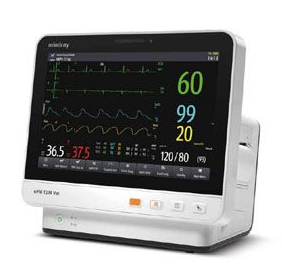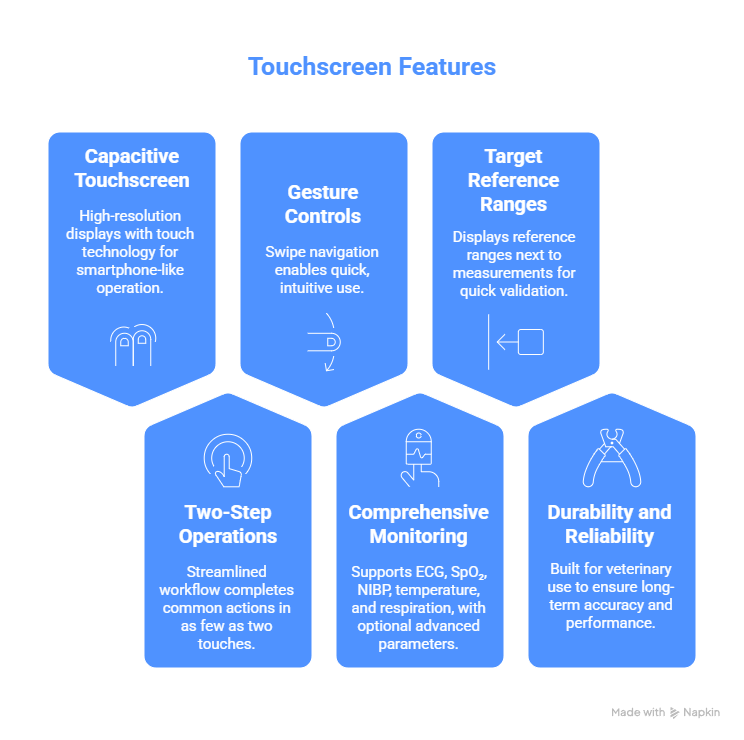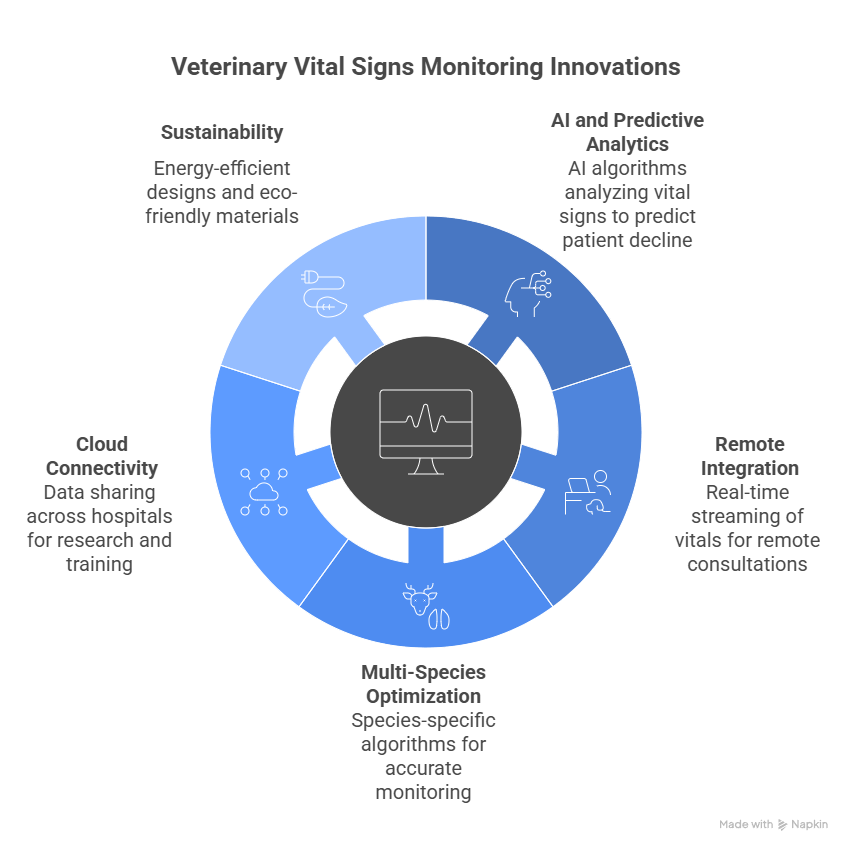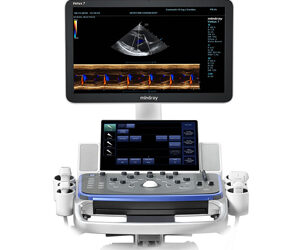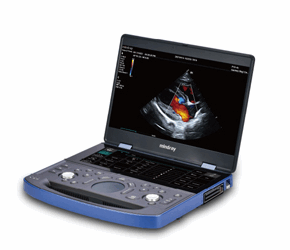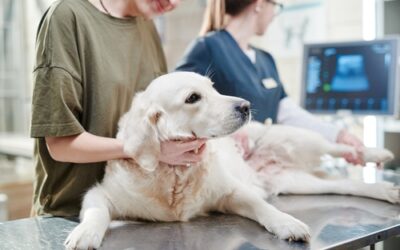In veterinary medicine, accurate and continuous monitoring of vital signs is essential for patient well-being, especially during anesthesia, recovery, or critical care. Veterinary vital signs machines, or patient monitors, are indispensable for this, providing real-time data on key physiological metrics.
These devices track heart rhythm, oxygenation, circulation, ventilation, and temperature, offering a comprehensive overview of a patient’s condition. This real-time information allows veterinary teams to detect problems early, standardize care, and improve patient outcomes by enabling data-driven decisions.
Investing in a vital signs machine enhances diagnostic capabilities, boosts patient safety, and elevates the standard of care in a practice
Why Veterinary Vital Signs Machines Matter
Because animals can’t report symptoms, objective monitoring is your earliest warning system. A modern vital signs machine helps you:
- Maintain anesthetic safety by tracking oxygen saturation (SpO₂), ECG, blood pressure (NIBP/IBP, if configured), respiratory rate (and EtCO₂ where equipped), and temperature.
- Spot complications sooner—hypoxia, arrhythmias, hypotension, apnea, or hypothermia—before they escalate.
- Standardize documentation across teams and shifts with consistent parameters and alarm thresholds.
This combination of vigilance and workflow consistency is what reduces variability and supports better patient outcomes across your practice.
How Do Veterinary Vital Signs Machines Work?
A veterinary vital signs machine is essentially a multiparameter monitor designed to track an animal’s physiological status continuously. To understand how these systems work, it helps to break down their components, sensors, and workflow.
1. Core Monitoring Components
- Electrocardiography (ECG):
Adhesive electrodes or clip-style leads attach to the animal’s skin or paw pads. These detect electrical activity generated by the heart with each beat. The monitor amplifies and filters these signals to display heart rate and rhythm on the screen. - Pulse Oximetry (SpO₂):
A clip sensor is placed on a non-pigmented area such as the tongue, ear, or toe web. It emits two wavelengths of light through capillary blood and measures absorption differences to calculate oxygen saturation. This reading provides real-time insight into how well oxygen is being delivered throughout the body. - Non-Invasive Blood Pressure (NIBP):
An inflatable cuff is placed around a limb or tail. The machine automatically inflates and deflates the cuff, detecting oscillations in arterial flow to estimate systolic, diastolic, and mean arterial pressure. This is invaluable for identifying hypotension under anesthesia. - Respiratory Rate and Capnography (EtCO₂):
Basic monitors count breaths using impedance changes in the chest detected via ECG leads. More advanced monitors integrate capnography by sampling exhaled gases through a small tube, analyzing CO₂ concentration to measure both respiratory rate and ventilation quality. - Temperature:
A probe is inserted rectally, esophageally, or attached to the skin, depending on the situation. Continuous temperature tracking is vital since animals under anesthesia are prone to hypothermia.
2. Data Processing and Display
Once the sensors collect data, the machine’s algorithms process it in real time. Advanced devices like the Mindray ePM 10/12M Vet filter out motion artifacts (for example, patient shivering or technician handling) and smooth the readings to avoid false alarms.
Values are displayed on a high-resolution touchscreen, often alongside waveforms such as ECG traces or capnography curves. Reference ranges can be customized by species, helping clinicians immediately identify abnormalities.
3. Alarm Systems
A vital signs machine isn’t just a passive display—it actively alerts staff to dangerous trends. Alarm thresholds can be pre-set (e.g., SpO₂ below 92% or heart rate above 200 bpm). If readings move outside the safe range, the system generates audible and visual alarms, ensuring timely intervention.
Modern monitors also incorporate “smart alarms” that consider context. For example, a transient drop in SpO₂ due to a sensor adjustment might not trigger the same level of urgency as a sustained decline.
4. Clinical Workflow Integration
- Pre-Anesthesia: Baseline vitals are recorded to assess patient stability and guide anesthetic drug choices.
- During Surgery: Continuous monitoring ensures oxygen delivery, ventilation, circulation, and thermoregulation remain within safe limits.
- Recovery & ICU: Machines continue tracking until patients regain stable, independent function.
The seamless integration of monitoring across these stages helps standardize care, reduce errors, and build confidence among veterinary teams.
5. Limitations and Considerations
While vital signs machines provide robust data, clinicians must understand their limitations:
- Poor probe placement can cause inaccurate SpO₂ readings.
- NIBP cuffs may be less reliable in very small exotics or extremely low-pressure states.
- Continuous clinical assessment (mucous membrane color, pulse quality, auscultation) should always complement machine data.
Core Functions & Must-Have Features
Key parameters most clinics require:
- ECG for rhythm and heart rate
- SpO₂ for oxygenation
- NIBP/IBP for perfusion
- Respiratory rate / (optional) EtCO₂ for ventilation status
- Temperature for thermoregulation under anesthesia and in recovery
Features that make a daily difference:
- Clear, configurable alarms and target ranges
- Touchscreen UI with minimal steps per task
- Multi-species sensors and accessories
- Durable build, easy cleaning, available consumables
- Optional data export/connectivity for case review/teaching
BOMImed’s Veterinary Patient Monitor
- Mindray ePM 10/12M Vet — A modular, multi-parameter veterinary monitor with 10″ or 12″ capacitive touch screens, gesture controls, comprehensive parameter monitoring, and precise algorithms designed to streamline routine workflows. Notable usability touches include two-step operations, customized configuration, target reference range display, and a durable build suited to everyday clinical use.
Where the ePM 10/12M Vet Fits Best
- General practice & surgery — A single, configurable monitor that covers pre-op, intra-op, and post-op needs without a steep learning curve.
- High-throughput clinics — Touch gestures and two-step workflows reduce setup time between cases.
- Teaching & protocol-driven teams — Target range displays and consistent parameter sets help standardize care and training.
Deep Dive: Mindray ePM 10/12M Vet
The Mindray ePM 10/12M Vet is designed specifically for veterinary applications, bridging everyday usability with advanced monitoring capabilities. It’s an excellent example of how modern veterinary technology blends safety, efficiency, and reliability in one system.
Key Features
- Capacitive Touchscreen (10” or 12”)
The monitor is available in two screen sizes, both with high-resolution displays. Capacitive touch technology allows intuitive operation—similar to using a smartphone or tablet. - Two-Step Operations
Efficiency is critical in busy practices. The ePM’s streamlined workflow reduces repetitive steps, letting clinicians complete common actions in as few as two touches. - Gesture Controls
Simple swipe actions enable quick navigation, reducing the cognitive load during high-pressure moments. - Comprehensive Monitoring
The system supports ECG, SpO₂, NIBP, temperature, and respiratory rate, with optional advanced parameters depending on configuration. - Target Reference Ranges
Built-in reference ranges display alongside current measurements, providing quick visual confirmation when a value is trending outside of safe limits. - Durability and Reliability
Designed for veterinary use, the monitor is built to withstand the rigors of daily clinical operations while maintaining accuracy over time.
Clinical Applications
The ePM 10/12M Vet can be used across the entire patient journey:
- Pre-Anesthesia Checks
- Establish baseline vitals prior to induction.
- Identify hidden conditions (arrhythmias, hypertension) that may affect anesthetic planning.
- Intra-Operative Monitoring
- Track heart rhythm and blood pressure during surgery.
- Ensure oxygen saturation remains within safe ranges.
- Watch for respiratory depression or apnea with integrated respiratory rate monitoring.
- Post-Operative Recovery
- Confirm patients are regaining normal vital signs.
- Detect post-anesthetic complications early.
- Document trends for post-op evaluation and discharge.
- Critical Care and Hospitalization
- Provide continuous monitoring in ICU or emergency cases.
- Support multi-patient oversight when integrated into clinic workflows.
Best Practices for Using Veterinary Vital Signs Machines
While the technology provides advanced capabilities, how it’s implemented makes the biggest difference.
- Pre-Use Checklist
- Perform self-test and calibration.
- Confirm accessories (ECG leads, SpO₂ probes, NIBP cuffs) are appropriate for patient size.
- Set customized alarm thresholds for the species and procedure at hand.
- Staff Training
- Train veterinary technicians and veterinarians on both standard and emergency workflows.
- Emphasize the importance of alarm response and interpretation.
- Provide periodic refresher sessions to maintain confidence and consistency.
- Maintenance & Service
- Schedule annual servicing through BOMImed-certified technicians.
- Replace consumables such as SpO₂ sensors and cuffs as recommended.
- Keep software updated for improved algorithms and functionality.
- Safety Protocols
- Place sensors correctly to ensure reliable readings.
- Avoid over-tightening cuffs on small animals, which can skew NIBP results.
- Always keep a backup manual method (e.g., stethoscope, Doppler) available for verification.
Linking Veterinary Technology and Outcomes
The adoption of advanced vital signs machines like the Mindray ePM 10/12M Vet doesn’t just improve workflow efficiency. It directly supports:
- Better patient outcomes – Early detection of abnormalities allows timely intervention.
- Higher staff confidence – Intuitive operation reduces the risk of user error.
- Clinic reputation – Advanced monitoring reassures pet owners and supports trust in veterinary services.
- Operational efficiency – Faster workflows and fewer errors reduce surgical delays and increase patient throughput.
New Features in Veterinary Vital Signs Monitoring
As veterinary medicine continues to evolve, so too will the role of vital signs machines. The Mindray ePM 10/12M Vet represents the current state of the art, but several trends are shaping the next generation of monitoring systems.
1. Artificial Intelligence and Predictive Analytics
Future monitors are expected to incorporate AI algorithms capable of predicting patient deterioration before it becomes clinically evident. By analyzing trends in heart rate variability, blood pressure fluctuations, or subtle oxygenation changes, AI could alert clinicians earlier than current threshold-based alarms.
2. Remote and Telemedicine Integration
With telehealth expanding into veterinary practice, the next generation of vital signs machines may allow remote consultation and oversight. Real-time streaming of vital signs from the monitor to a specialist or referral hospital could help general practices manage high-risk cases without immediate transfer.
3. Multi-Species Optimization
While most monitors are adaptable across species, expect to see models that come pre-configured with algorithms tailored to cats, dogs, horses, and exotics. This would allow species-specific alarm thresholds and interpretation, reducing the burden on staff to adjust settings manually.
4. Cloud Connectivity and Data Management
Connectivity is becoming standard in human healthcare, and veterinary monitors will follow. Cloud-based storage of patient monitoring data could support teaching hospitals, research facilities, and multi-location practices in analyzing outcomes, training staff, and standardizing protocols.
5. Sustainability and Resource Efficiency
As clinics become more environmentally conscious, the focus on re-usable accessories, energy-efficient designs, and waste-reduction features will grow. Future monitors may integrate eco-friendly materials or low-energy modes to align with sustainability goals.
FAQs
What is a veterinary vital signs machine?
A veterinary vital signs machine, also called a patient monitor, is a medical device that continuously measures and displays an animal’s physiological parameters. These typically include ECG (heart rhythm), oxygen saturation (SpO₂), non-invasive blood pressure (NIBP), temperature, and respiratory rate. Some models can also measure capnography (EtCO₂).
Why is a vital signs machine important in veterinary practice?
Because animals cannot communicate distress, objective monitoring is the only reliable way to detect complications early. Vital signs machines provide continuous, standardized data during anesthesia, recovery, and critical care. This helps veterinarians intervene before conditions become life-threatening.
Can the same monitor be used for cats, dogs, and exotics?
Yes. The ePM 10/12M Vet is designed for multi-species practices. By adjusting accessories (such as cuff size or SpO₂ probes), it can monitor small pets, large dogs, and exotic animals effectively. Species-specific protocols may be required for optimal accuracy.
How do I choose the right veterinary vital signs machine?
Focus on five key areas:
- Parameters measured – Does the machine cover ECG, SpO₂, NIBP, temperature, and respiratory rate?
- Ease of use – Is the interface intuitive for staff?
- Durability – Can it withstand daily clinical use?
- Service support – Is there local servicing and training available?
- Scalability – Will it meet your future needs as your caseload grows?
For most clinics, the ePM 10/12M Vet strikes the right balance.
How often should a veterinary vital signs machine be serviced?
Annual servicing is recommended for calibration, software updates, and performance verification. High-volume practices may schedule service more frequently. Daily function checks—such as verifying SpO₂ probe accuracy and inspecting ECG leads—should also be part of routine protocols.
What’s the difference between a vital signs machine and a multiparameter monitor?
The terms are often used interchangeably. In veterinary medicine, “vital signs machine” typically refers to devices that capture essential parameters (ECG, SpO₂, NIBP, temp, respiratory rate). “Multiparameter monitor” may refer to higher-end systems capable of advanced monitoring such as invasive blood pressure, capnography, or anesthetic agent analysis.
Can veterinary vital signs machines connect to electronic records?
Some models, including the ePM 10/12M Vet, can export or integrate data into digital systems depending on configuration. As connectivity advances, expect broader compatibility with veterinary practice management software and teaching hospital databases.
What safety protocols should be followed when using these machines?
- Always place probes and cuffs correctly to avoid inaccurate readings.
- Customize alarm thresholds for species and patient size.
- Train all staff on machine operation and troubleshooting.
- Keep backup manual methods available for verification.
How much training does staff need to operate a vital signs monitor?
The ePM 10/12M Vet is designed with ease of use in mind—touchscreen navigation, two-step workflows, and gesture controls minimize training needs. However, staff should undergo formal training sessions, practice emergency workflows, and receive refreshers at least annually.
What sets BOMImed apart as a supplier?
BOMImed is the official Canadian distributor of Mindray veterinary equipment, including the ePM 10/12M Vet. Beyond sales, they provide installation, service, training, and local support—ensuring clinics can rely on their monitors for years to come.









